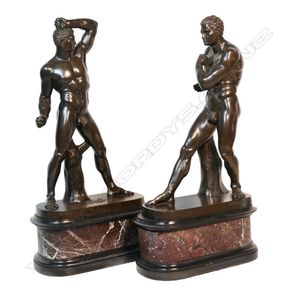Bronze Models of Canova's Pugilists
A pair of late 19th century bronze models after Antonio Canova (1757-1852) of the pugilists Creugas and Damoxenos, probably Italian. Each with their Italian name 'Creugante' and 'Damosseno,' inscribed to base, Creugas with his fist resting atop his head and Damoxenos poised to strike his fatal blow. Each raised on a marble base. Fine original patina, height 63.5 cm and 62.5 cm. Note: Canova's original models are housed in the Pio Clementino Museum, part of the Vatican Museums. He began sketches and models of the figures in the 1790s and completed the marble figure of Creugas in 1801. Pope Pius VII acquired it for the Vatican collections and commissioned the figure of Damoxenos as well. Canova's figures helped to fill the void left after Napoleon pillaged ancient sculpture from the Vatican collections.
You must be a subscriber, and be logged in to view price and dealer details.
Subscribe Now to view actual auction price for this item
When you subscribe, you have the option of setting the currency in which to display prices to $Au, $US, $NZ or Stg.
This item has been sold, and the description, image and price are for reference purposes only.
- Patination / Patina - In broad terms, patination refers to the exterior surface appearance of the timber, the effect of fading caused by exposure to sunlight and air over the course of a century or more, changing the piece to a soft, mellow colour.
As patina is very difficult to replicate, it is one of the most important guides to determining the age of furniture.
Patina is also the term applied to the bloom or film found on old bronzes due to oxidisation. - Bronze - An alloy of copper and tin, traditionally in the proportions of about 9 parts of copper to 1 part of tin.
The discovery of bronze in Western Asia in the 4th century enabled people to create metal objects which were superior to those previoulsy possible because of its strength and hardness, and it has been used throughout the world for weapons, coins, tools, statuary and other decorative items.
It is very fluid in a molten state, and its hardness, strength when set, and non-corrosive properties makes it most suitable for casting sculpture.
This item has been included into following indexes:
